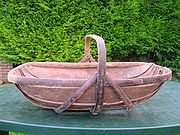
Sussex trug
Encyclopedia

Drawknife
A drawknife is a traditional woodworking hand tool used to shape wood by removing shavings. It consists of a blade with a handle at each end. The blade is much longer than it is deep...
. The body of the trug is made of five or seven thin boards of cricket bat willow, also hand-shaved with a drawknife. Most trugs have wooden feet. Rough forms of trugs have been made for hundreds of years, often by farmers for their own use or by woodsman or bodger
Bodging
Bodging is a traditional wood-turning craft, using green wood to create cylindrical wooden woodturning via a traditional wooden-bed, polelathe, most commonly chair legs and stretcher poles, historically for the Windsor chair manufacturing industry.-Etymology:The origins of the term are obscure...
s. They are probably made in Sussex because of the abundance of chestnut coppice and willows found on the marshes. In the early nineteenth century making Sussex trugs developed into quite an important industry, most of this happening in the village of Herstmonceux
Herstmonceux
Herstmonceux is a village and civil parish in the Wealden District of East Sussex, England. The parish includes Herstmonceux Castle, the village of Cowbeech and a number of smaller hamlets.-History:...
where there is still one producer.
Shapes and sizes became standardised, the most well-known shape being the "common or garden" trug ranging in volume from one pint to a bushel. However, there is a diverse range of traditional trugs from garden and oval trugs to the more specialised "large log" and "walking stick" trugs. Sussex trugs were shown at the Great Exhibition of 1851 where they were admired by Queen Victoria who purchased several for members of the Royal family. Since then they have always been sought after as the quintessential garden basket. They are renowned for their strength and durability.

